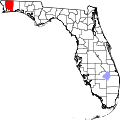Gulf Breeze, Florida | |
|---|---|
 View from ISS Expedition 72 (2024) | |
 Location in Santa Rosa County and the state of Florida | |
| Coordinates: 30°21′26″N87°9′50″W / 30.35722°N 87.16389°W | |
| Country | |
| State | |
| County | Santa Rosa |
| Incorporated | August 10, 1961 |
| Government | |
| • Type | Council-Manager |
| • Mayor | Cherry Fitch |
| • City Manager | Samantha D. Abell |
| Area | |
| 22.14 sq mi (57.34 km2) | |
| • Land | 4.68 sq mi (12.12 km2) |
| • Water | 17.46 sq mi (45.22 km2) |
| Elevation | 16 ft (5 m) |
| Population (2020) | |
| 6,340 | |
| • Density | 1,355/sq mi (523.1/km2) |
| • Metro | 509,905 (Pensacola metropolitan area) |
| Time zone | UTC-6 (CST) |
| • Summer (DST) | UTC-5 (CDT) |
| ZIP codes | 32561, 32562, 32563 [2] |
| Area code | 850 |
| FIPS code | 12-28000 [3] |
| GNIS feature ID | 283485 [4] |
| Website | https://cityofgulfbreeze.us/ |
Gulf Breeze is a city in Santa Rosa County, Florida. It is located between Downtown Pensacola and Pensacola Beach, and is part of the Pensacola Metropolitan Area. The population was 6,340 at the 2020 census, up from 5,763 at the 2010 census.
Contents
- History
- Geography
- Climate
- Demographics
- 2010 and 2020 census
- 2000 census
- Arts and culture
- Points of interest
- Gulf Breeze Library
- Education
- Gulf Breeze Academic Plaza
- Infrastructure
- Notable people
- See also
- References
- External links
Gulf Breeze is the nearest city to Pensacola Beach, and provides utility services to the island, and most of South Santa Rosa County covering over 33 square miles. The census designated places of Oriole Beach, Tiger Point, and Midway are considered to be a part of unincorporated Gulf Breeze by Santa Rosa County, and carry Gulf Breeze mailing addresses.




